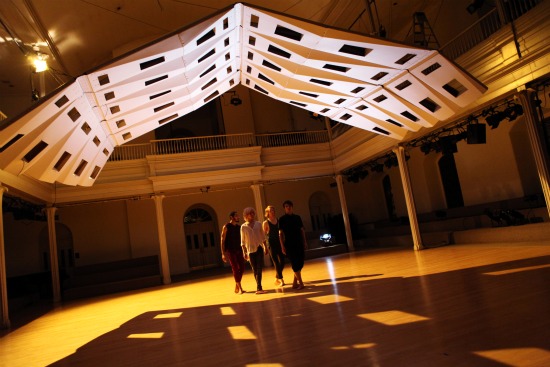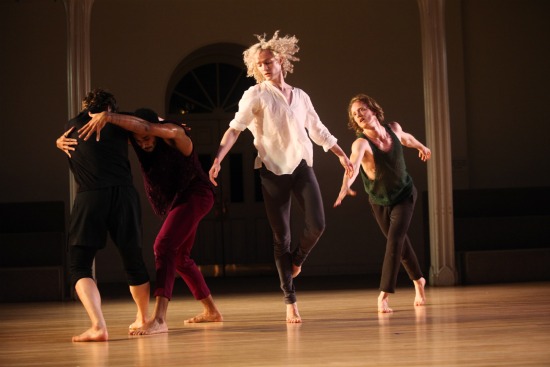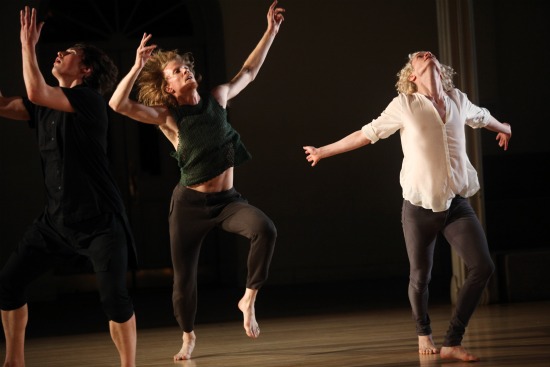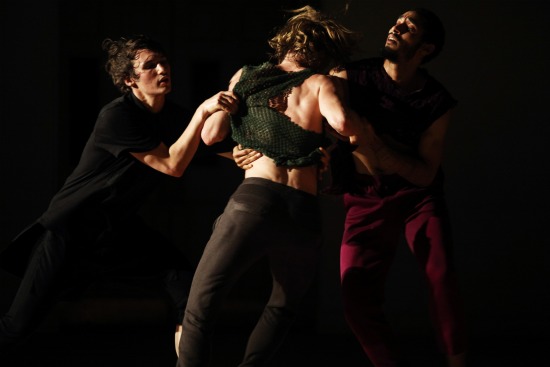
Niall Jones, Paul Monaghan, Matthew Rogers, and Michael Ingle in Tere O'Connor's Cover Boy. Photo: Julieta Cervantes
One of the most intriguing things about Tere O’Connor’s Cover Boy is its overall rhythmic structure. During the hour it takes the piece to unfold, the movements of the four performers (Michael Ingle, Niall Jones, Paul Monaghan, and Matthew Rogers) set up subtle interplays between asserting and backing off, between attacking and melting.
This dynamic formalizes and expresses the implications contained in the title. Yes, photos of any one of these four could grace the cover of a magazine for men. The performers also convey the wariness of the closeted gay whose desires are kept undercover, especially the desires of a boy just discovering his sexual identity. By extension, the sense of isolation they experience can afflict anyone (an artist in particular) who works outside the mainstream.
The ambience is both enigmatic and poetic. The set by Aptum Architecture (Roger Hubell and Julie Larsen) consists of a huge, white object suspended over the performing area in St. Mark’s church; its shape is that of a set of hinged wings, with small, regularly spaced “windows” pitting it (an airplane, a bat, a folded city building?). It could be plastic or cardboard; you can detect grommets and what might pass for rivets. This object projects a sense of lightness and slight awkwardness, especially at the beginning when the wings move slightly. Near the end, lighting designer Michael O’Connor aims spots of amber, blue, and violet up through the apertures in this “cover” and spangles the walls above the church balcony. Meanwhile while traces of religious choral music filter toward an “amen” in James Baker’s richly textured. score for guitar, violin, other instruments (Baker is a versatile percussionist), muffled noises, and the dancers’ voices muttering or singing.
The men’s behavior veers between the enigmatic and the quotidian. They enter taking jiggly baby steps, with one foot leading the other, then back up to the four corners of the dancing floor, where they undulate their arms dreamily and make soft gestures as if molding a piece of air between their hands (these will recur). They look tentatively around, perhaps recognizing one another, perhaps sensing a common bond, and begin to converse quietly. The speaking too will recur; it seems anchored both to the choreographic process and to the here-and-now. At one point, Monaghan approaches the other three, apparently commenting on his costume. Another time they agree that they’ve done something well. The fact that we can rarely hear what they say adds to the impression of clandestine encounters.
Immediately after the opening moments, the dancers turn to face outward and are hurled fiercely back by imagined forces or individuals that they rise to confront several times. Once, the “blows” knock the wind out of them; the next time, they laugh. Over the course of Cover Boy, they can be giddy, sober, horny, puzzled, unsure. Once, after Rogers has performed a remarkable solo, the others want to catch him; he roars, screams; they grapple. You can’t be sure whether they’re helping him or bullying him.
From the beginning, O’Connor allows us to see and relish the wonderful performers’ individuality. Jones’s movements are rife with small, sinuous complications; often he seems flirtatious. Monaghan looks very young and quietly confident; his pale, handsome face and halo of curly golden hair gives him the air of a Piero della Francesca angel. He’s the only one who aces the runway moment (the others show us how inept they are at this parading or how equivocal about it). Ingle is solider, his feelings more hidden. Rogers, who has worked with O’Connor for seven years, is a profoundly complex performer. Skinny, gangling, he often stares out like a deer caught by headlights.
Over and over, always attentive to one another and watchful for what might be outside their group, the colleagues investigate the polarities I mentioned. In unison, they strike a ballet-class pose and crumple it. They hold hands and strain against that grip, their faces showing the effort; gradually they sink lower, still pulling, then slowly recover and move on. They pair up and kiss deeply, after which they back away from their partners on tiptoe, their hands making a gesture that resembles the turning off of faucets.
And, of course, they dance—sometimes extravagantly, as if indulging in some romantic imagining, sometimes with private sensuality. The intriguing, variegated choreography has them sweep across the space on private journeys or consensual missions. They thrust or fling themselves into straightforward motion but also undulate or otherwise equivocate the trajectories of their limbs. They talk, sing, fall silent.
In O’Connor’s non-narrative world, stories lurk. Fugitive images too: “at the brink,” “look before you leap,” “friend or foe,” “ is anyone watching?” But, more powerfully, a phrase of Shakespeare’s—“this band of brothers”—binds together this fascinating, moving, beautifully imagined and performed work.




I agree completely that this work was beguiling: a seductive blend of irony and candor. I liked that the piece continually interrupted itself, that it kept refusing to perpetuate its own illusions through a dense collaging of beginnings and endings. The net result of this frisky compositional structure is that the performers had space to explore the psychic ganglia that O’Connor so intensely evokes. The night I was there the audience roared its support.
Wish I could have seen this tantalizing work, all the bet for the holidays, gigi